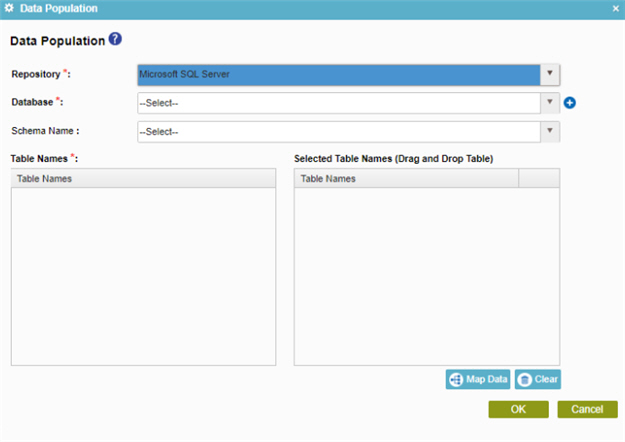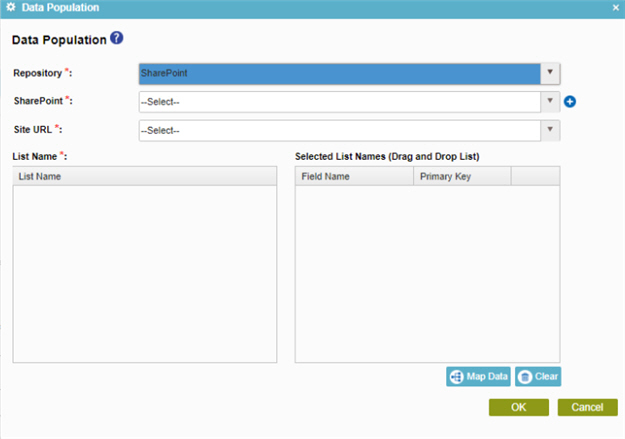Figure: Data Population screen
Figure: Data Population screen
How to Start
Do one of these :
On the Application Explorer screen ,
do one of these :
Click Misc Data Population
Fields
Field Name
Definition
Repository
Function:
Specifies whether to write the data to a database SharePoint
Accepted Values:
Microsoft SQL Server - Writes the data to a Microsoft SQL Server database.Sharepoint - Writes the data to a SharePoint list.
Default Value:
None Example:
Refer to :
Database
Function:
Specifies the access token database
To Open this Field:
On the Data Population screen, in the Repository list, select
Database .
Accepted Values:
A list of access token . Default Value:
None Accepts Process Data Variables:
No
Example:
Refer to :
Schema Name
Function:
Specifies your schema.
To Open this Field:
On the Data Population screen, in the Repository list, select
Database .
Accepted Values:
A schema name from the list.
When you select a database, the schemas associated with the database
show in this field.
Default Value:
None Example:
Refer to :
Limitations:
Add Token
Opens this Screen:
Access Token for Database To Open this Field:
On the Data Population screen, in the Repository list, select
Database .
Function of this Screen:
Configure an access token to a database
SharePoint
Function:
Specifies the access token SharePoint
To Open this Field:
On the Data Population screen, in the Repository list, select
SharePoint .
Accepted Values:
A list of access tokens configured for your environment.
Default Value:
None Accepts Process Data Variables:
No
Add Token
Opens this Screen:
Access Token for SharePoint To Open this Field:
On the Data Population screen, in the Repository list, select
SharePoint .
Function of this Screen:
Configure an access token
to SharePoint
Table Names
Function:
Shows all the table names of the specified database
To Open this Field:
On the Data Population screen, in the Repository list, select
Database .
Accepted Values:
A database table names selected from the database.
Default Value:
None Accepts Process Data Variables:
No
Example:
Refer to :
Selected Table Names
Function:
Specifies the database
To Open this Field:
On the Data Population screen, in the Repository list, select
Database .
Accepted Values:
The table names selected from the Table Names list.
Default Value:
None Accepts Process Data Variables:
No
Example:
Refer to :
Site URL
Function:
Specifies the URL for your SharePoint
To Open this Field:
On the Data Population screen, in the Repository list, select
SharePoint .
Accepted Values:
A valid SharePoint site URL .Default Value:
None Accepts Process Data Variables:
Yes
Example:
List Name
Function:
Shows the name of your SharePoint .
To Open this Field:
On the Data Population screen, in the Repository list, select
Database .
Accepted Values:
The name of your SharePoint list .
Default Value:
None Accepts Process Data Variables:
No
Selected List Names
Function:
Specifies the name and primary key of your SharePoint
To Open this Field:
On the Data Population screen, in the Repository list, select
SharePoint .
Accepted Values:
Field Name - Specifies the name of your SharePoint list.Primary Key - Specifies the primary key to be used for each list.
Default Value:
None Accepts Process Data Variables:
No
Map Data
Opens this Screen:
Schema Mapper screen Function of this Screen:
Maps SharePoint fields, form fields, web methods, or other
input sources to an XML schema. .


 > Data Population
> Data Population  .
.


